The best automotive emergency car kits in 2025
Make sure you're prepared for every eventuality when you're on the road

Every driver should have one of the best emergency car kits somewhere in their car. Driving is a risky business, and there's plenty of opportunity for things top go wrong. Making sure you're prepared for every eventuality could make a huge difference to your day. It might even save your life.
There's a huge range of pre-made emergency car kits out there, and the contents can vary pretty wildly. No single kit will have everything you need, but the best ones will over all the basics and give you chance (and space) to fill any gaps that may arise.
I've been driving in all different kids of conditions over the years, and I've had my fair share of issues pop up when I'm behind the wheel. As such, I've made sure I keep my car well stocked — and can make sure your vehicle is too. It never hurts to be over-prepared, especially when the consequences of being caught out in the cold can be so serious.
Here are the best emergency car kits we've tested, that you can buy right now.
The best emergency car kits you can buy right now

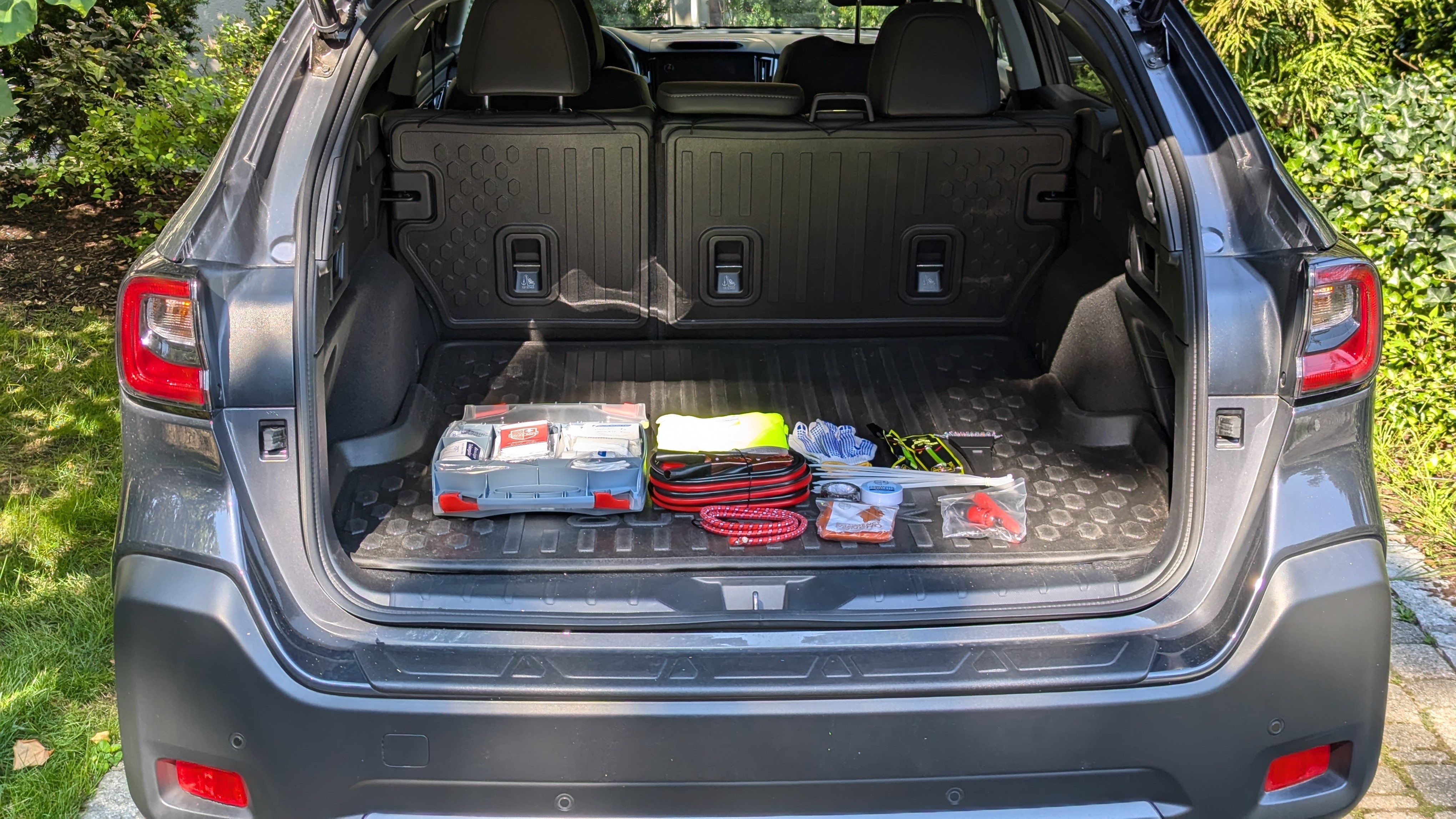
Specifications
Reasons to buy
Reasons to avoid
While pretty pricey, as far as auto emergency kits go, the Swiss Case 2-in-1 Roadside Emergency Kit makes up for it by offering an incredible selection of items. Some of the basics are missing, but it does have the best-equipped first aid kit we've seen in an emergency kit.
The handy folks out there will also benefit from the range of different tools that should help you get back on the road — including a set of work gloves. They're not the hardiest looking things, but they should prove useful enough in a pinch. The bag isn't the biggest, which means it slid into those empty gaps pretty easily, though that doesn't leave a lot of space for adding extra pieces.
Read our full Swiss Safe 2-in-1 Roadside Car Emergency Kit review


Specifications
Reasons to buy
Reasons to avoid
It's rare to find an auto emergency kit that has everything, and the US Safety Kit All-in-One Emergency Car Kit definitely follows that pattern. Then again it does include a lot of incredibly useful and hardy equipment that easily save your life in an emergency.
If you're without a tire pump or fire extinguisher, this is a kit worth considering. In our mind the only thing it's really missing is a small tool kit, and maybe a shovel if you live in particularly snowy or muddy parts of the country. Sadly it's all a little too big to fit under our car seat, so this may need to be stowed in your trunk until needed.
Read our full US Safety Kit All-in-One Emergency Car Kit review
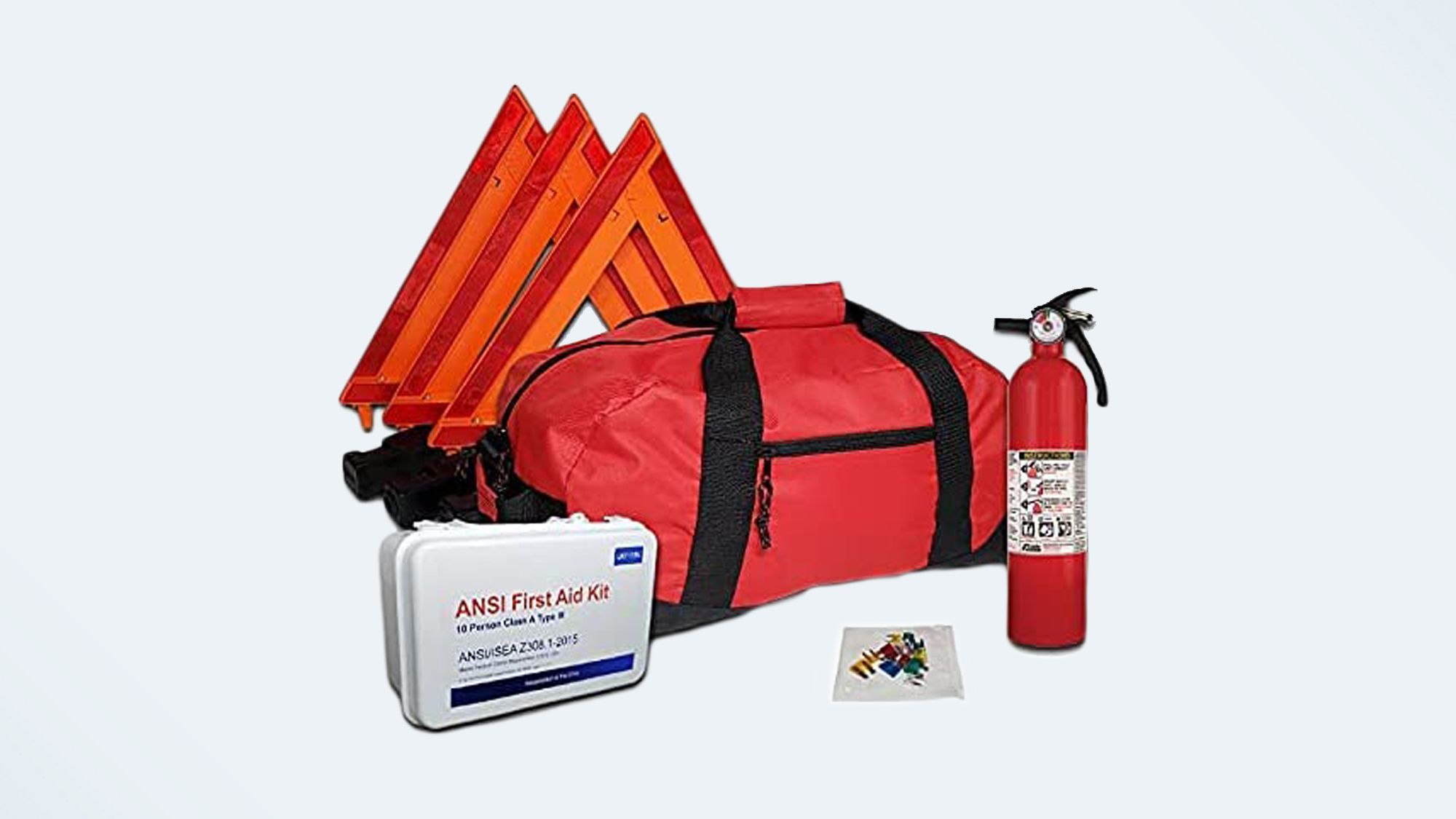

Specifications
Reasons to buy
Reasons to avoid
Neatly packaged in a small duffle bag that has plenty of room to spare, the DOT Essential OSHA ANSI Compliant Kit is more than all the government acronyms in its name would suggest. It’s an excellent emergency car kit, and with some of the best equipment of its type that we’ve seen so far.
Included is a fire extinguisher, an incredibly extensive first aid kit, an LED flashlight and the best reflective triangles this side of a state trooper’s squad car. There’s a lot of stuff the DOT Essential Kit doesn’t have, like a tire inflator or jumper cables, but what it does offer is some of the best in its league. Luckily we were able to make room to stow all the extra components you might need as and when you buy them.
Read our full DOT Essential OSHA ANSI Compliant Kit review.

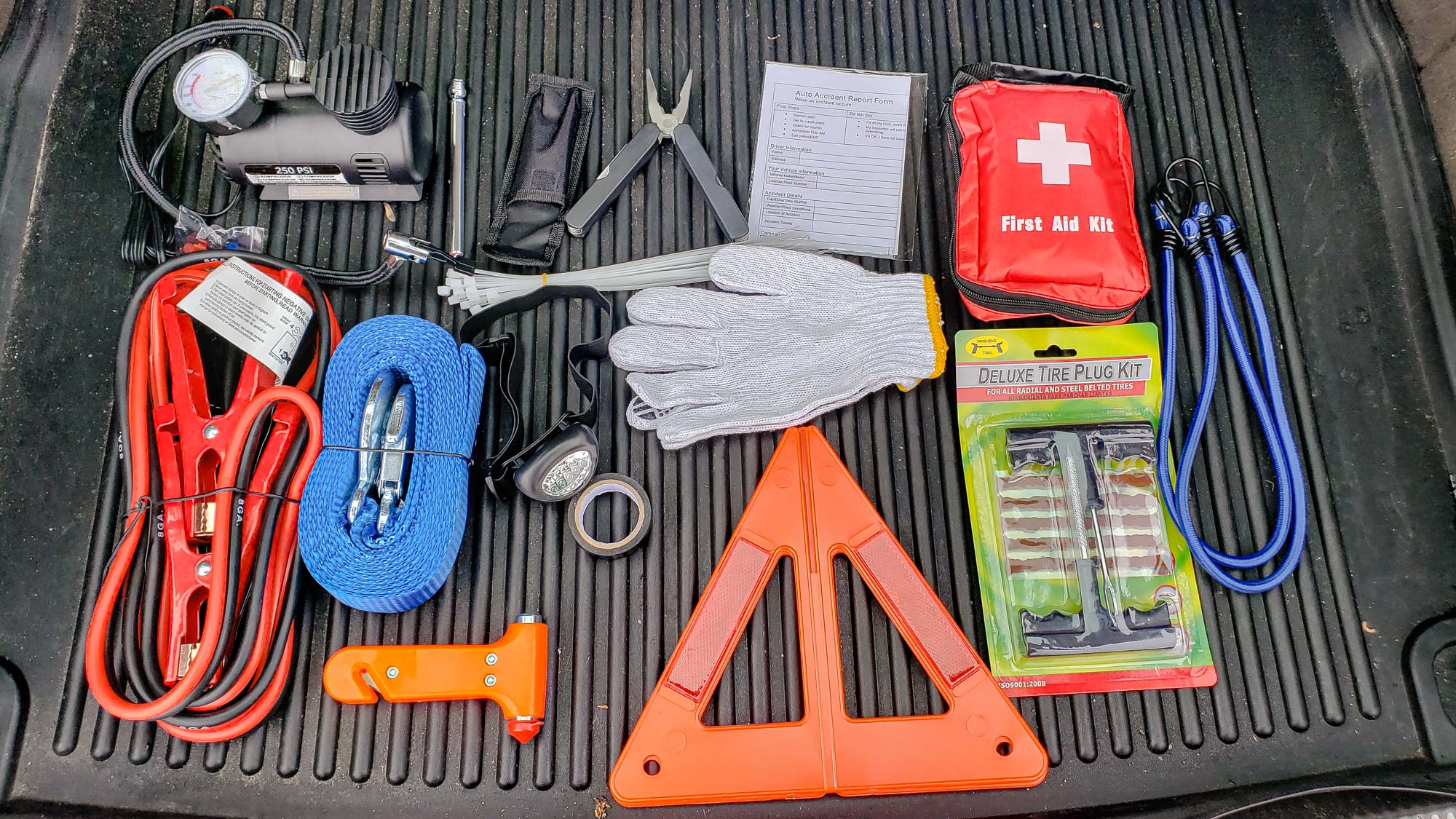
Specifications
Reasons to buy
Reasons to avoid
The First Secure Car Emergency kit is a great start to building a fully-equipped emergency kit of your own. Not only does it pack in a great selection of important equipment, it’s also small enough to fit under your car seat for quick access when you need it most.
Inside you’ll find a tow strap, jumper cables, multi-tool alongside an air compressor and tire repair kit. Sadly it does without the likes of a fire extinguisher and shovel, both of which can prove to be useful under the right circumstances. Worse still, the bag isn’t big enough to add any additional extras. But, at $80, it’s a solid choice to get yourself going.
Read our full First Secure Car Emergency Kit review.
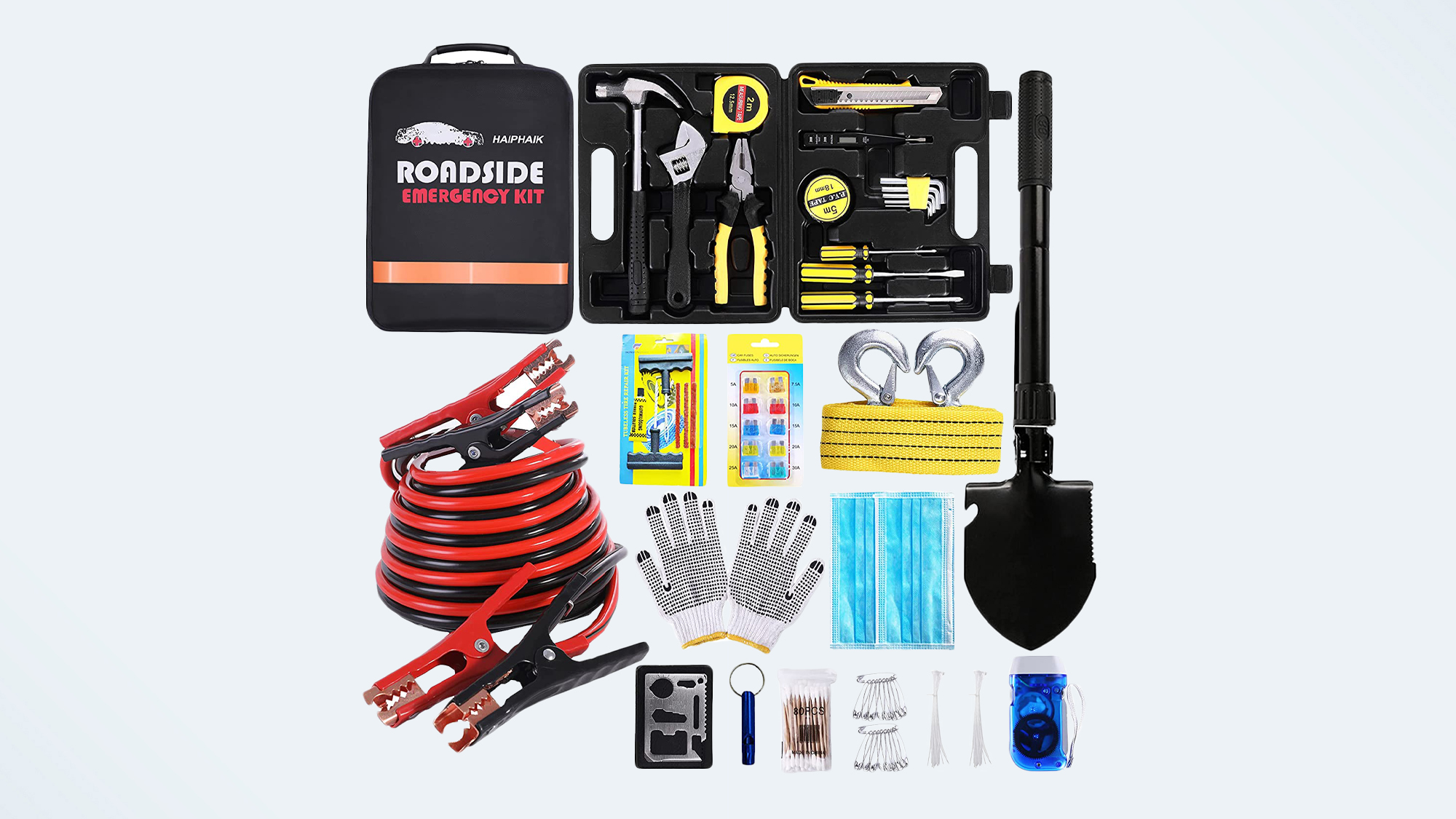
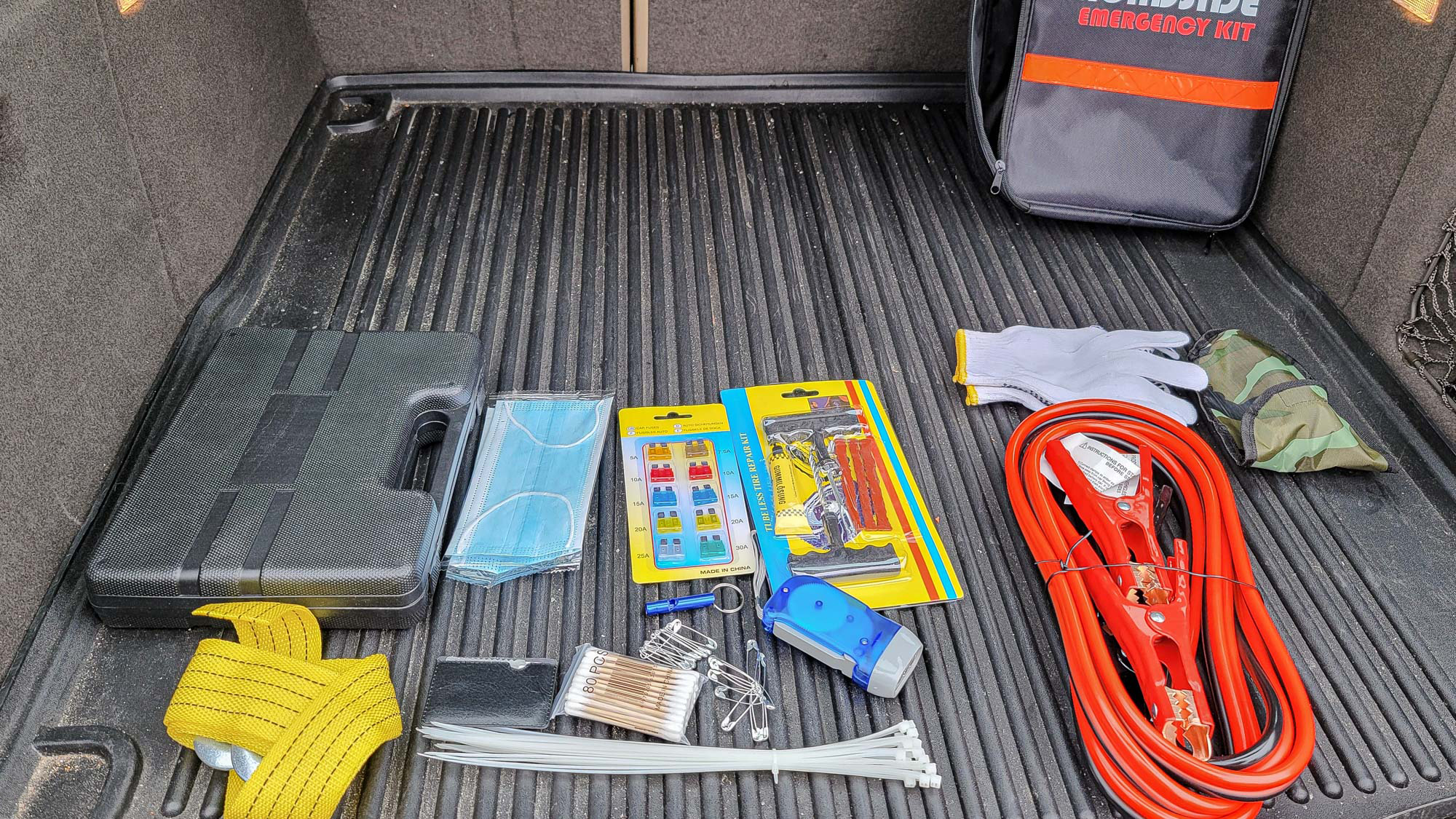
Specifications
Reasons to buy
Reasons to avoid
While it still misses out on some key items, the Haiphaik Emergency Roadside Toolkit is still great value at just $48. As the name suggests the emphasis is on the tools inside, including things like a hammer, knife, tape measure - and other pieces you don’t find included in other emergency car kits.
Of course the value is offset by the fact it’s missing a number of important pieces of equipment, including the fire extinguisher and a tire inflator. But if you’re looking for something to get you going, with the intention of adding to it early on, this might be the kit for you.
Read our full Haiphaik Emergency Roadside Toolkit review.
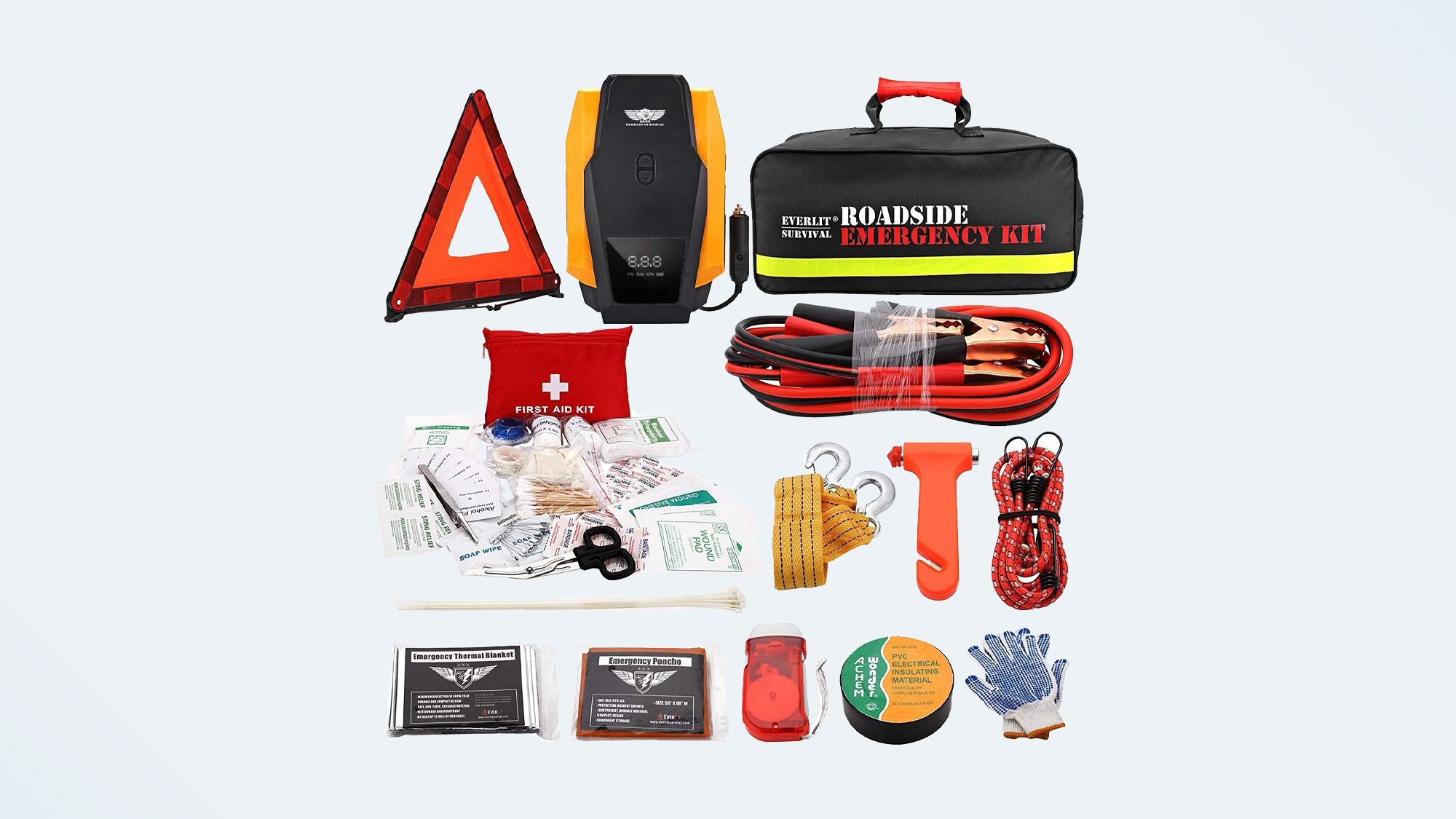

Specifications
Reasons to buy
Reasons to avoid
Another kit that lacks some basic essentials, the Everlit Roadside Assistance Kit still comes with a number of quality items to handle some of the problems you may encounter on the road. 12 foot jumper cables are a major asset, and the first aid kit is noticeably better than what a lot of competitors seem to think is adequate.
But no emergency car kit is perfect, and the Everlit kit includes enough well-made equipment to get you started. Just be sure to buy another bag to keep any additions inside, because Everlit’s doesn’t have room for anything extra.
Read our full Everlit Roadside Assistance Kit review.
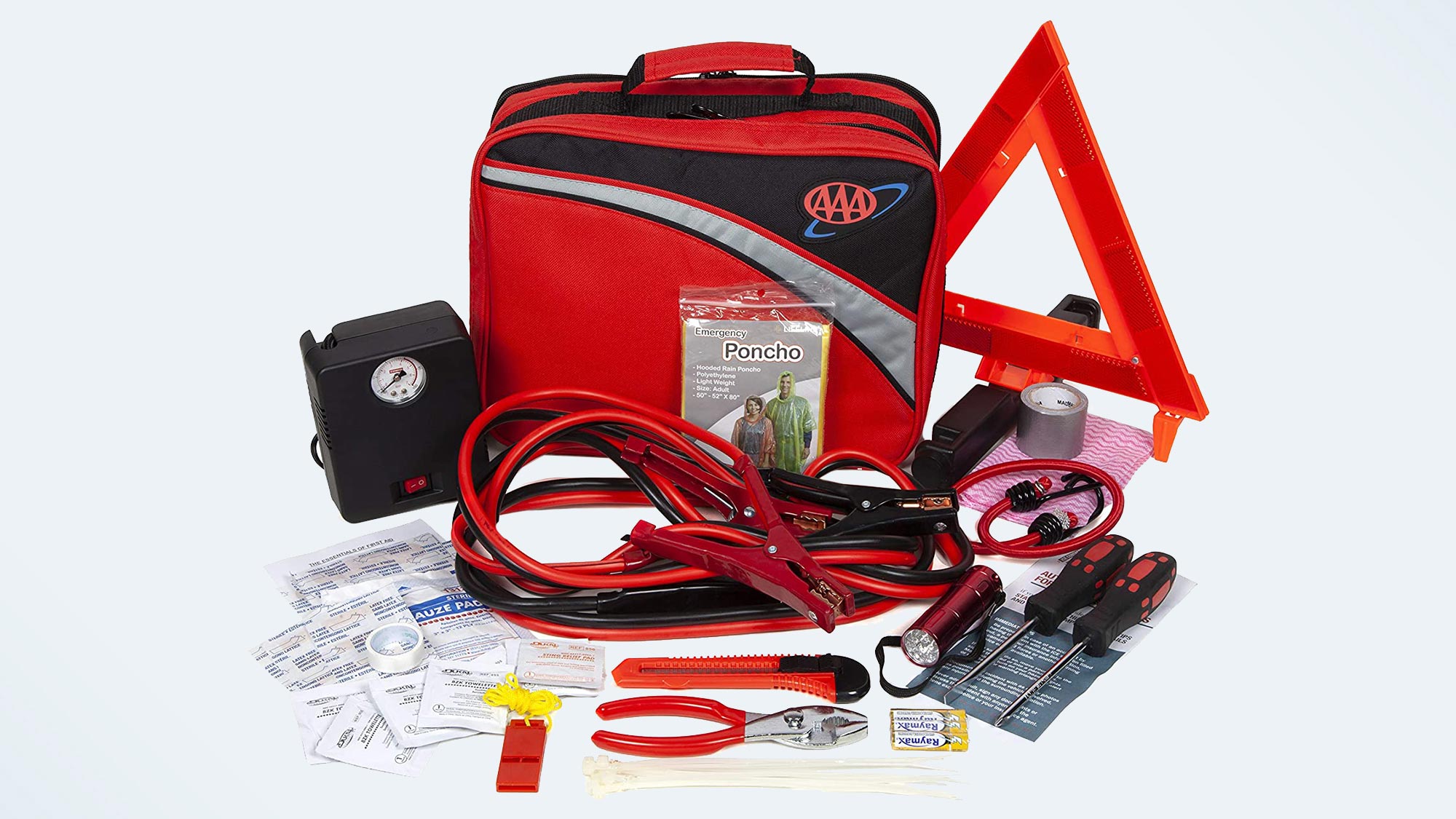

Specifications
Reasons to buy
Reasons to avoid
The Lifeline Premium Excursion Road Kit may carry the AAA logo, though the branding doesn’t make it any more premium than kits by lesser-known brands. Still it has several driving must-haves, including jumper cables, tools and everything you need to patch up and re-inflate a leaking tire.
While pricey, what you get in this kit is very well made - and should last you for several years at the very least. That said it still falls short of being a complete emergency car kit, despite its association with America’s best known roadside assistance network.
Read our full Lifeline Premium Excursion Road Kit review.


8. Lianxin Roadside Car Emergency Kit
Our expert review:
Specifications
Reasons to buy
Reasons to avoid
Lianxin's Roadside Car Emergency Kit is a very basic bag of kit. It's got a bunch of basic items you'd find in plenty of other kits, with basic tools, jumper cables, tow ropes, a window breaker and so on. However the miniature vacuum cleaner is the standout star of the collection — especially considering the price.
While we can't think of when it might be helpful in an emergency, the vacuum and its various attachments do mean you've got what you need to keep your car clean and tidy. You will need to pick up some extra items to make up for the kit's shortfalls, but if you need something quickly and cheaply this is a solid option. Particularly if you're a bit of a neat freak.
Read our full Lianxin Roadside Car Emergency Kit review
FAQs: What should you look for?
Why do you need an emergency car kit?
Roads are a dangerous place, and the one thing you should act as though anything that could go wrong will go wrong. You can't always rely on roadside assistance, or a good Samaritan, to be there when you need them.
Making sure you're prepared for as many eventualities as possible could be the difference between you making it to your destination and spending a cold night by the side of the road — or worse. it doesn't matter whether it's as simple as a dead battery or something a lot more serious.
What's the benefit of buying a pre-made kit?
Buying a pre-made emergency car kit means you can pick up a lot of basic kit in one go. Otherwise you'd be shopping around picking up a bunch of smaller items in different orders, and that can be a pain. Especially if you need to pay for shipping, or visit physical stores.
A pre-made kit is a good starting point, letting you pick up important items quickly and easily. On top of that most of these kits, even the most basic options, come with some kind of carry case to help you keep all your new tools organized in a single place.
What should I look for in an emergency car kit?
No emergency car kit is going to have everything, and you will likely need to buy more at some point in the future. That said, you should still look for some basic items before you commit to buying. A few options to look for are jumper cables, a glass hammer and seatbelt cutter, a tow cable, reflective gear, a light and a tire inflator — whether that's a foot pump or a powered air compressor.
These prices vary a lot, does it matter how much I pay?
In a lot of cases you do get what you pay for. A $50 emergency car kit will often be better than a $15 kit, but the same isn't necessarily true for $200 kits. The same goes for branding, and that kit featuring the famous brand name or TV show logo often contain the exact same items as the kits from companies you've never heard of.
Kit makers also like to advertise big numbers, often fudging the numbers by counting the contents of tool kits or first-aid kits as standalone items. So don't be overpay because of overzealous marketing and use some common sense when reading the contents list.
Where should I keep my emergency car kit?
It may seem counter-productive, but not every piece of emergency equipment needs to be kept in the same place. What's more important is that emergency tools are in a place where you can reach them.
For instance, I keep items like my tire compressor and jumper cables are in the trunk, but my glass hammer and flashlight are in the glove box. Likewise my fire extinguisher is under my passenger seat, where I can grab it at a moment's notice.
Is there anything I should avoid buying?
There's no chance of buying the wrong emergency car kit. Any kind of emergency equipment is better than having none at all. Just remember that the kit in question is essentially a starting point, and the more you buy the better off you'll be when you find yourself in a pickle.
Essential emergency car kit contents
There are a few tools that every driver should have in their trunk, covering some of the more common issues you'll face on the road. Here are our recommendations:
- Jumper cables: Whether your engine needs a jump, or you're helping out a fellow driver, these are must haves. A basic set of red and black jumper cables will do, though the better ones are marked for polarity and measure at least 8 feet.
- Tire inflator: Whether you have a flat, or the pressure in your tires has dropped a little too low, every driver needs a tire inflator. Manual pumps will do, but powered models will plug into your 12V socket to refill a tire in just a few minutes. These work best combined with a patch kit or can or foam tire filler
- Fire extinguisher: This is the law in some parts of the world, and with good reason. A fire extinguisher can help save lives for obvious reasons, and may be the difference between a slightly scorched char and a burnt-out wreck
- First aid kit: Another self-explanatory addition. A well-stocked kit includes bandages, gauze pads, tape, and antiseptic. It's also worth throwing in burn cream, ice packs, emergency water, latex gloves and a pair of scissors
- Duct tape: It's never a bad idea to have duct tape, whether you're in your car or out.
- Flashlight and reflective gear: You never know when an accident will happen, so you need to be able to see. I opt for a wind-up flashlight that will always have power, though a head torch and glow-sticks may also be useful. Reflective triangles and a basic hi-viz vest are essential to make sure other drivers can see you too.
- Tools and gloves: Some problems can be fixed on the side of the road, and tools makes that happen. A simple multi-tool is fine in a pinch, but proper tools are more reliable. Good staring points include a hammer, adjustable wrench, pliers, screwdrivers and a set of sockets.
- OBD-II scanner: The best OBD-II scanners can easily fit in your glove box, and can be the difference between identifying a dangerous engine fault and a mere loose gas cap.
- All-weather gear: Always be prepared to suffer an issue in the worst weather. We suggest adding at least a poncho, gloves, and if you live in snow-prone areas a foldable shovel.
- Other useful kit: A bungee cord can keep a crumpled hood in place long enough to get home while a whistle can help alert those driving by of a hazard and they might even stop to help. Meanwhile a combo glass breaker and seatbelt cutter can help get out of a burning or sinking car.
- A roadside assistance plan: Some breakdowns will need professional help. Some kits include this, so if you don’t have auto club or other break-down service, this one item can be worth the price of the entire kit.
How we test roadside emergency kits
To test roadside emergency kits and separate the good from the bad and the ugly, we start with the bag it came in. That involves measuring and weighing a fully-loaded bag, while also checking for ruggedness and extra features like reflective strips.
This was followed up by checking if there was room for additional equipment that hadn’t been included, and checking for any dividers that will help interior organization. The final bag test was seeing if it would fit under the seat of our test car — a 2014 Audi A4 AllRoad.
Each kit’s contents were checked against the checklist in the previous section. Rather than counting individual items, as manufacturers are wont to do, the contents were grouped into major categories and checked over one by one.

Important things we went looking for were dedicated polarity markings on jumper cables, whether the tow straps had hooks, and what sort of nighttime equipment was included. if the kit had a hand-cranked flashlight, we’d test the battery by cranking it 20 times and seeing how long it lasted.
The performance of any air compressor/tire inflator was timed, checking to see how long it would take to from 20 pounds per square inch to 35 psi in a front tire. Once done the compressor’s built-in pressure gauge was compared against a standalone gauge.

For those kits that included a fire extinguisher, we looked at the size and type as well as the spray’s rated duration. For the first aid kit, one of the most important items, we checked the contents for the kind of things you’d need for a roadside emergency: Gauze pads, bandages, tape, gloves and antiseptics, plus scissors, tweezers and other medical tools.
Checking the toolkits involved checking what tools were actually included, plus any accouterments like tape, electrical fuses or gloves. The same was true of any multi-tools that may have been included instead. On the rare occasion a kit included roadside assistance coverage, we checked out the company involved and what the plan actually included.
While you're picking up the best automotive emergency kits for your car, be sure to check out some other key essentials. The best OBD-II scanners for quick diagnosis of problems, the best dash cams to keep a record of your roadly exploits, and the best car heads-up displays to put the essential data in your line of sight.
Sign up to get the BEST of Tom's Guide direct to your inbox.
Get instant access to breaking news, the hottest reviews, great deals and helpful tips.

Tom is the Tom's Guide's UK Phones Editor, tackling the latest smartphone news and vocally expressing his opinions about upcoming features or changes. It's long way from his days as editor of Gizmodo UK, when pretty much everything was on the table. He’s usually found trying to squeeze another giant Lego set onto the shelf, draining very large cups of coffee, or complaining about how terrible his Smart TV is.
